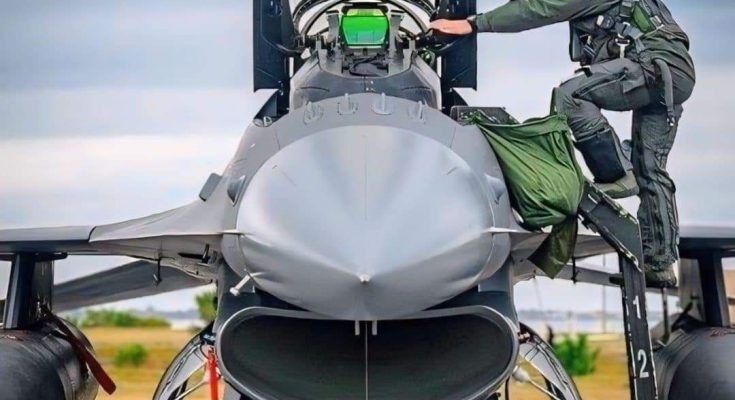The F-16 Fighting Falcon, commonly referred to as the F-16, is one of the most widely recognized and versatile multirole fighter jets in the world. Developed by General Dynamics (now Lockheed Martin) in the 1970s, the F-16 was designed to be a highly maneuverable, cost-effective fighter that could perform a variety of roles, ranging from air-to-air combat to ground attack missions. Its performance, reliability, and adaptability have made it a cornerstone of air forces globally, serving more than 25 countries and with over 4,600 aircraft produced.
Design and Structure
The F-16 is a single-engine, single-seat aircraft known for its small size and lightweight design, which contribute to its remarkable agility and speed. It is a 4th-generation fighter that incorporates advanced avionics and fly-by-wire flight control systems. The aircraft’s flying wing design and blended fuselage provide excellent aerodynamics, while the side-mounted control stick in the cockpit enables more intuitive and precise handling for the pilot.
The Heart of the F-16: The Engine
The F-16 is powered by a Pratt & Whitney F100-PW-200 or F110-GE-100 engine, depending on the variant. This turbofan engine provides an impressive thrust-to-weight ratio, allowing the aircraft to reach speeds exceeding Mach 2 (around 1,500 mph or 2,414 km/h). The engine’s high thrust is complemented by the aircraft’s lightweight structure, which enables superior acceleration, high-speed intercepts, and agile maneuvering.
Fly-By-Wire Technology
One of the most groundbreaking features of the F-16 is its fly-by-wire control system. Unlike traditional mechanical control systems, which use cables and pulleys, fly-by-wire uses electronic signals to control the aircraft’s flight surfaces. This allows for more precise control of the jet’s movements, especially during high-G maneuvers. The fly-by-wire system provides automated stability for the aircraft, compensating for any aerodynamic instabilities caused by extreme flight conditions. This makes the F-16 exceptionally stable and agile, even in high-speed, high-maneuver situations.
Multirole Capability
The F-16 was initially designed as a day fighter intended for air superiority missions, but it quickly evolved into a multirole fighter, capable of carrying out a variety of operations in both the air and on the ground. Its ability to perform diverse tasks, such as close air support, strike missions, and reconnaissance, makes it a highly adaptable platform.
-
Air-to-Air Combat: In air superiority missions, the F-16 excels in engaging enemy aircraft. It is equipped with a range of advanced radar systems, including the AN/APG-68 radar, which allows it to detect and engage enemy fighters at long ranges. The F-16 carries a variety of air-to-air missiles, including the AIM-7 Sparrow and AIM-120 AMRAAM, for long-range interception, and the M61 Vulcan cannon for close-range dogfighting.
-
Ground Attack: The F-16 is also highly effective in precision strike roles. It is capable of carrying precision-guided munitions (PGMs), such as laser-guided bombs (LGBs), and GPS-guided bombs (JDAMs). This makes it a reliable platform for hitting ground targets with pinpoint accuracy, whether it’s for close air support or strategic strikes against enemy infrastructure.
-
Electronic Warfare: In addition to its combat abilities, the F-16 can also be equipped for electronic warfare missions. Some variants of the F-16 are outfitted with advanced electronic countermeasure systems, allowing it to disrupt enemy radar and communications or jam incoming missiles, enhancing its survivability in contested environments.
Cockpit and Avionics
The cockpit of the F-16 is equipped with modern avionics that improve pilot awareness and control. The pilot uses a hands-on throttle and stick (HOTAS) system, which allows them to control the aircraft’s flight and weapons systems without removing their hands from the controls. The glass cockpit displays critical flight and weapons information on digital screens, helping the pilot to make quick decisions in fast-paced combat situations.
Versatility and Longevity
Over the decades, the F-16 has undergone numerous upgrades to keep it relevant in modern warfare. These upgrades include improved radar systems, advanced targeting pods, more powerful engines, and new avionics. As a result, the F-16 remains one of the most capable and cost-effective fighter jets in the world, providing excellent air superiority while maintaining multirole flexibility.
The F-16’s adaptability is evident in its ability to serve in both peacekeeping and combat roles. It has been used in a wide variety of military operations, from no-fly zone enforcement to combat air patrols, and it continues to be a workhorse for the U.S. Air Force and allied air forces around the world.
Conclusion
In summary, the F-16 Fighting Falcon is a multirole fighter jet that combines agility, speed, and versatility, making it one of the most successful and widely used fighter aircraft ever built. With its advanced avionics, fly-by-wire technology, and multirole capabilities, the F-16 remains an essential part of modern air forces, capable of performing a wide range of missions in both air-to-air and air-to-ground operations. Despite being a 4th-generation fighter, the F-16 continues to evolve, proving that its design and capabilities are still highly effective in today’s dynamic combat environment.



